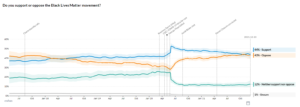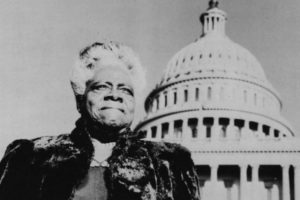Combating Racism – A Cause for Hopefulness
Hopefulness is a mindset that helps us see the bright side of things and plan for a better future. Despite the continued systemic racism in our country, in the 18 months that I have been writing about racism, its impacts for our country, and ways to combat it, I have seen some rays of hope.
One of the most significant events giving cause for hopefulness this year was the election of Kamala Harris as the first Black woman to be sworn in as Vice President of the United States. Shortly thereafter, she swore Raphael Warnock in as the first Black senator from the state of Georgia. And Tishaura Jones became the first Black woman to be elected mayor of St. Louis.
According to a Civiqs poll that compared support for Black Lives Matter between April 2017 and June 2020, the support of registered voters increased from 37% to 52%. Opposition to the Black Lives Matter movement dropped from 41% in 2017 to 30% in 2020.

Muriel Bowser, Mayor of Washington, D.C., renamed a two-block area on 16th Street near the White House “Black Live Matter Plaza” and had the Department of Public Works paint the words, “Black Lives Matter” in yellow, 11-meters-long letters on the street leading to the White House.

Merriam-Webster agreed to update its three-part definition of racism after a 22-year-old Black woman requested that it include a definition of systemic oppression. The recent college graduate said she was motivated by conversations she had with people who referenced the iconic dictionary to justify their racist views.
The Associated Press changed its longstanding style to capitalize the word Black when it is used to identify a community of people who identify as Black, including the African diaspora and people in Africa. The news agency, whose style guide is followed by most news organizations, said, “Use of the capitalized Black recognizes that . . . the term reflects a shared identity and culture rather than a skin color alone.”
Two juries have made their decisions on facts, rather than on the race of the defendant. In 2020, a teenage Black girl, at risk to herself, photographed a White police officer killing George Floyd. This year a jury convicted Derek Chauvin of second- and third-degree murder and second-degree manslaughter. He was sentenced to 22.5 years in prison. Also this year, the three white men charged with killing Ahmaud Arbery as he jogged through a White neighborhood, were found guilty on multiple murder counts by a jury consisting of 11 White men and women and one Black man.
The convictions of innocent Black men are being rectified. After serving 43 years in prison for a crime he did not commit, Kevin Strickland was finally exonerated and released last month. Anthony Broadwater, also wrongfully convicted of a crime he did not commit, had his conviction vacated.
In addition, Ed Johnson and the “Scottsboro Boys”—Haywood Patterson, Olen Montgomery, Clarence Norris, Willie Roberson, Andy Wright, Ozzie Powell, Eugene Williams, Carley Weems and Roy Wright—were exonerated posthumously for crimes they did not commit.
Since the murder of George Floyd on May 25, 2020, 202 Confederate monuments and symbols have been brought down, according to data gathered by the Southern Poverty Law Center. In 2021 alone, a total of 51 Confederate symbols have been relocated, renamed, or removed from public spaces. This includes 11 monuments and 40 memorials. In addition, another 31 symbols are facing pending removals.
Some of these include:
- Statues of Generals Robert E. Lee and Stonewall Jackson were removed from their bases in Charlottesville, Virginia in July.

The statue of former Confederate General Robert E. Lee is removed from Monument Avenue in Richmond, Virginia on September 8, 2021. PHOTO BY RYAN M. KELLY/AFP VIA GETTY IMAGES
- In Georgia, a statue of Confederate General Joseph E. Johnston was relocated from downtown Dalton, and a Confederate obelisk was removed from the Decatur Square with plans to replace it with a monument honoring the late Georgia civil rights activist, John Lewis.
- Earlier this month, a controversial statue of Confederate general Nathan Bedford Forrest was removed from its perch alongside I-65 in Tennessee.
- The Robert E. Lee Statue has been removed from the U.S. Capitol and Virginia plans to replace it with a statue of civil rights icon Barbara Johns, the brave 16-year-old who led a student strike for equal education in 1951. Her case was one of five that were consolidated into the pivotal Brown v. Board of Education Supreme Court ruling that declared segregation unconstitutional in 1954.
In addition, Confederate statues have been or will be removed in Alabama, Arkansas, Delaware, Florida, Indiana, Kentucky, Louisiana, Minnesota, North Carolina, Oklahoma, and South Carolina.

In February, 2022 history will be made when the statue of Mary McLeod Bethune will be placed in Statuary Hall in the U.S. Capitol, making her the first Black person to have a statue there. In 2016, then-Gov. Rick Scott (FL) authorized removal of the statue of Confederate Gen. Edmund Kirby Smith, who was born in Florida, from the U.S. Capitol. Bethune, a civil rights activist and educator born to former slaves, will take Smith’s place. Bethune started a school in Daytona, Florida with a commitment to provide Black girls a higher quality education. The school, which combined with the Cookman Institute, formed Bethune-Cookman, a coeducational high school, in 1923. That school is now a university. To learn more about this famous woman, click here.
The NASCAR professional automobile racing association earlier this year banned the Confederate flag at its races. And vowed to do better in addressing racial injustice. “The Black community and all people of color have suffered in our country, and it has taken far too long for us to hear their demands for change. Our sport must do better. Our country must do better,” NASCAR President Steve Phelps told drivers and fans at the beginning of a race.
Officials of the National Football League (NFL) are re-evaluating claims for compensation by players who were impacted by a race-based formula used to measure cognitive impairment, which has skewed payouts along racial lines. For more on this subject, see my newsletter of June 27, 2021.
Since George Floyd’s death, businesses have begun to consider their role in sustaining inequalities. “Chief Diversity Officer” became the fastest-growing role among C-suite positions. According to LinkedIn, the number of postings for Chief Diversity officers grew by 84%.
Quaker Oats, which is owned by PepsiCo, retired its “Aunt Jemima” brand of pancake mixes and syrups after 131 years. The manufacturers of Uncle Ben’s rice, Cream of Wheat porridge, Mrs. Butterworth’s syrup and Eskimo Pie ice cream brands are considering renaming or retiring their products.
This year, on the 100th anniversary of the Tulsa Massacre, President Biden became the first President to formally memorialize the event and Greenwood Rising, the state-of-the-art history center honoring the legacy of the Tulsa Massacre, opened in August.
Juneteenth, also known as Jubilee Day, Emancipation Day, and Black Independence Day, became a federal holiday and was observed as such this year. Juneteenth commemorates June 19, 1865, which marked the emancipation of the last remaining Blacks held in slavery in the Confederacy.
While there is still much work to be done to eradicate systemic racism, these rays of hopefulness can motivate us to use our inner strengths to cultivate change. Watch for next week’s newsletter when I share specific actions we can each take to bring about change.
In the meantime, I wish you all a new year of good health, happiness, and peacefulness.